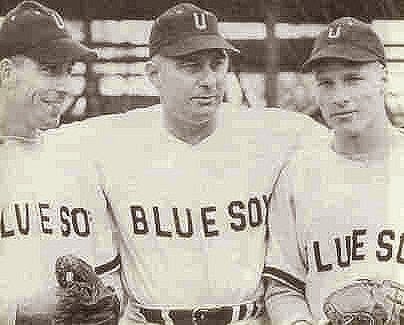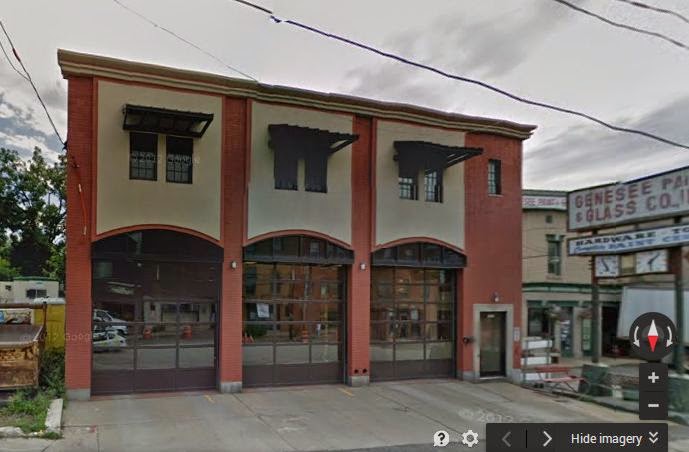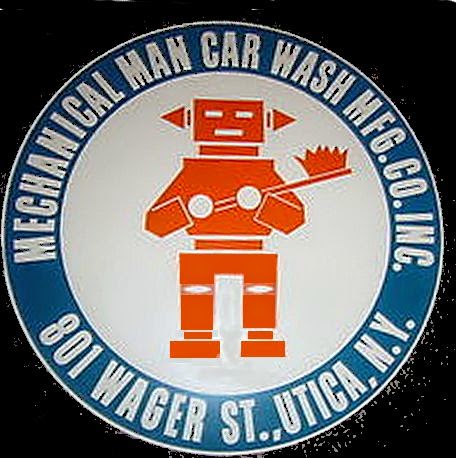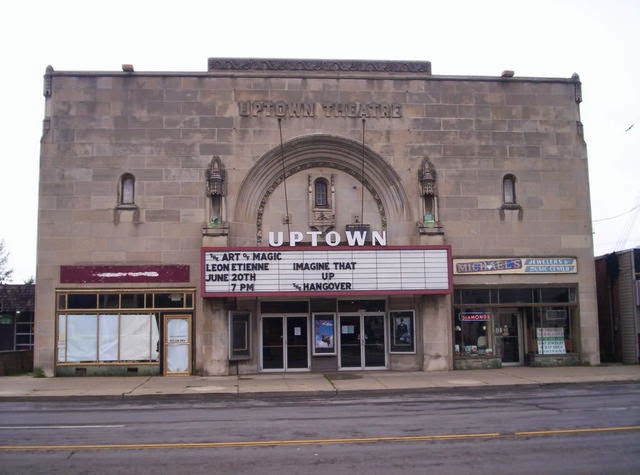Above, Utica's City Hosptial. You're looking at the front door that faced South Street. There was a small campus of buildings where the shopping center now sits on Eagle and Mohawk. I was brought here for a Tetanus shot when I was a kid. The porches in the photo were long gone. Below is another view.

Below, the flag of the Utica Morning Herald from 1899.
Umpires who served the Utica Blue Sox, a municipal baseball team in the 1930's and 40's.
A Blue Sox coach with two of the players.
Above, a Kut brand knife from Utica Cutlery. Ca. 1948.

Above, the Rome and Delta Lake Railway. Ca. 1900

If you take a close look at the photos above and below, you'll see a graphic representation of what has happened to the commercial center of Utica where comparison years are 1948, above, and 2013, below. Note the number of buildings that have been torn down.
When I came down into the valley from my home where I lived in the Catskills, after a few miles I would cross the NY State Thruway just before reaching the Hudson River. I knew a farm family in the the town whose parents completely re-oriented the plans for a house they were building in the early 1950s so they could sit on their front porch and watch the cars and trucks go by on the Thruway. Such was the fascination of people at the time the road was built. I wonder how folks on Herkimer Road felt during the same decade.
This is not Holy Trinity's original church before the stone structure was built. Else there would be a crucifix at the top of the steeple.
Sure. His first weekend away at school and off he goes to Summit Park in Oriskany for R&R!
And old neighbor gave me an ancient straw hat. They're heavier than I had anticipated. That's OK, I really had no place to wear one. I looked all around town for a trolley but couldn't find one.
Here's the old Armory on Rutger Street. View is up Park Ave on the western edge of Steuben Park.
James Schoolcraft Sherman was a United States Representative from Utica, New York and the 27th Vice President of the United States under President William Howard Taft (1909-1913.)
If the above monument looks vaguely familiar, you probably saw it in your headlights as you and your girl friend were coming down from the Eagle late one night. It's right on the 90 degree turn at the top of the hill on what is now known as Master Garden Road running up from Oneida Street. The monument sits in the New Forest Cemetery and is a memorial to Justus Henry Rathbone, founder of the Knights of Pythias with lodges all over the land. Rathbone was born in Deerfield, educated at Colgate and eventually found his way to the nation’s capitol. He was an actor, composer, school teacher and evidently made a lot of friends. He worked for the U.S. Treasury. The Knights of Pythias took their name from a character in the play by the Irish poet John Banim about the legend of Damon and Pythias.
Above, one of my favorite postcards. Fiona found it. I can just see myself headed out Oneida Street a hundred years ago, having put a dollar's worth of gas in the tank, and wondering how far it would take me. Including the return trip, of course.
Workers on strike at one of the mills in NY Mills.
Above, this young man was spending his time in 1949 just as I did ten years later. Crowding my younger brother out of bedroom I had radios stacked on one wall and I worked other Hams around the United States. I tried the attic, but of course it was too cold in winter and too warm in summer. Radio has been a life long hobby and I still use my key more often that the advanced digital technology on modern radios. I still get a thrill from putting up an antenna and contacting other Hams in Europe or North Africa, as well as enthusiasts all over the country.
The corner of Catherine and Mohawk Streets. A brief glimpse of East Utica during a parade in the late 1940s.
Infants Home orphanage. I have not yet discovered where this was.
Above, I don't know where this was either.
This was known at various times as the Home for Aged Couples and the Sunset Nursing Home. It was directly across the street from the new and current Faxton Hospital. Sunset Ave.'s name was changed from Perkins Ave. in honor of the Home, I've read.
Hard to see in this photo, but here's the pump house that lifted water from Hinckley Lake and sent it on down to Utica.
Unknown newspaper boy. I nominate his image as a stand-in for William Foley's, the newsboy who turned in the alarm for more fire fighting equipment at the Genesee Flats Fire. See "Billy Foley's Morning" or the longer version, "Blame," at:
http://www.windsweptpress.com/essays.htm
Master Story List at http://www.windsweptpress.com/stories.htm
After the Barge Canal was built about a mile north of the Erie Canal, the latter was filled in to provide a surface for Oriskany Boulevard through Utica. In the above photo, workmen and teams of horses take down one of the Erie's many bridges in Utica.
The three photos below show activities at the Utica Orphanage, which was located on the northeast corner of the Parkway and Genesee Streets. Girls in a cooking class, girls in a sewing class and children in the dispensary with the nurse.


Above, a medicinal dispensary on Mary Street in Utica around 1900.
This
is the Fraser Building, a popular store in Utica. It burned around 1900 but was
saved . Newspaper ads for large well known stores seldom
included an address, so it was difficult figuring exactly where this
building was located. But after careful study of the window pattern and
other evidence, I believe this store is the same building I called
Woolworth's fifty years later.
Here's the steamer from the No. 7 Engine Company. I'm not sure where Station No. 7 was at the time, but today it's on Park Ave. just a few doors from Oneida Square.
On left is today's UFD Engine No. 7. Below is the Station No. 7 on Park Ave. and Oneida Square.
At one time The No. 1 steam engine was at the fire station on Park and Oneida Square. Engine No. 2 was in the firehouse directly opposite the entrance to St. John's Church on John Street before moving to Central Fire Station when it was built in 1912.
I have no photos of the old No. 2 Station on John and Bleecker Streets.
Again for reference, here is the UFD in the late 1880s.
A pleasant presentation of the Utica Library. For some reason I always thought it was a Carnegie library, but it was donated by T.R. Procter.
That's right, mechanical car wash systems were manufactured in Utica.
The following photos were taken by Fiona O'Downey. They are the keystones in the arches over windows on the facade of the Olbiston Apartments on the corner of Genesee Street and Clinton Place. The Olbiston was built on the ruins of the Genesee Flats, which burned to the ground in 1896. Fiona and the late Jon Hynes and myself did quite a bit of research on the fire and planned a novel (or something) about the four people who died that morning when they were caught in the fire. A couple of places to go for more information are Fiona's Facebook page, "On Genesee Hill," at:
https://www.facebook.com/fiona.odowney?fref=ts
For the researched history, go to the Busy Corner Forum on Probaords at:
http://clipper220.proboards.com/thread/2238/history-genesee-flats-fire
A treatment and a few pieces that will eventually be included in On Genesee Hill are contained in our OGH website at:
http://www.windsweptpress.com/ogh1.htm
Master Story List at http://www.windsweptpress.com/stories.htm
Below, Penny Arcade viewing machines. A wheel of stiff cards slapping one by one past a gate that stops each card from moving for a fraction of a second to provide the illusion of motion. If the cards just flew by without momentarily stoopping, we'd see only a blur. Motion Picture projectors work on the same principle.
Hey, that's Great Grandpa Patrick, the city treasurer.
Golf for both men and women became quite opular in Utica in the 1920s and 30s.
I don't remember this diner. It must have been gone by the late 1950s when I walked home to Cornhill after a date. I often missed the last bus home from North Utica while I tarried too long on her front porch.
Above, how many shows did you recognize?


























































